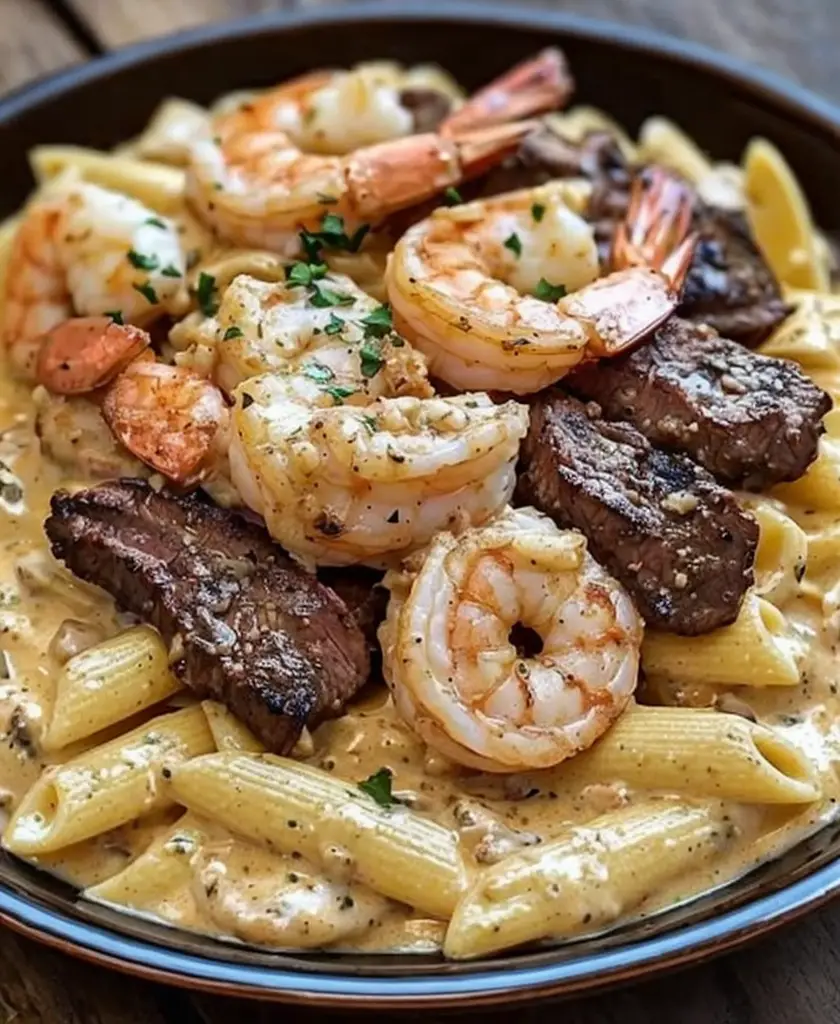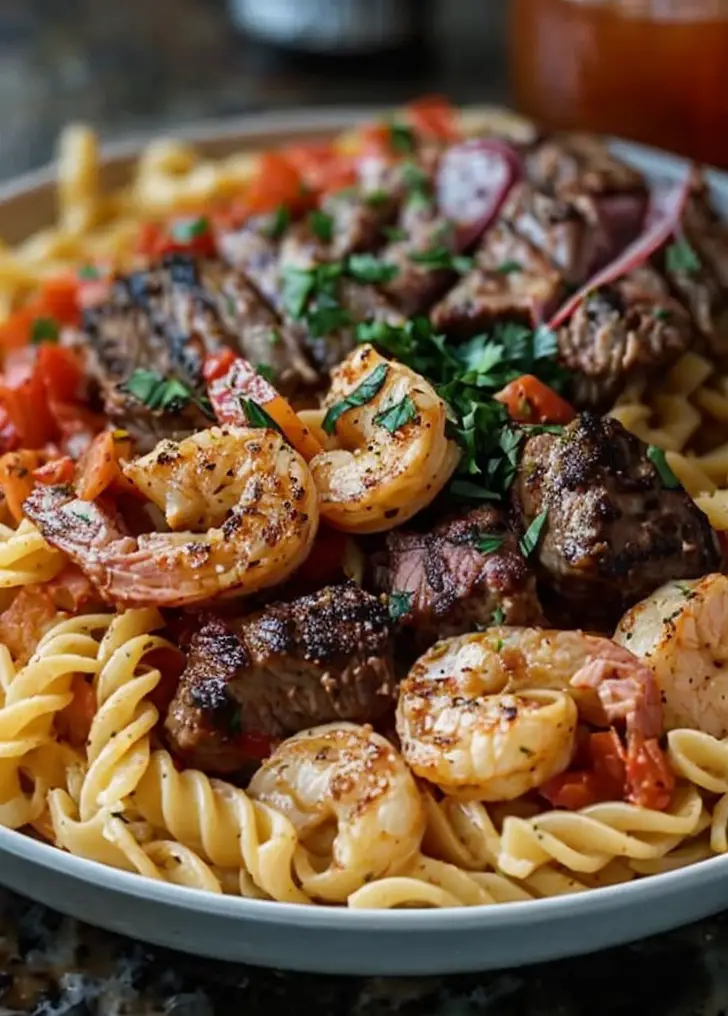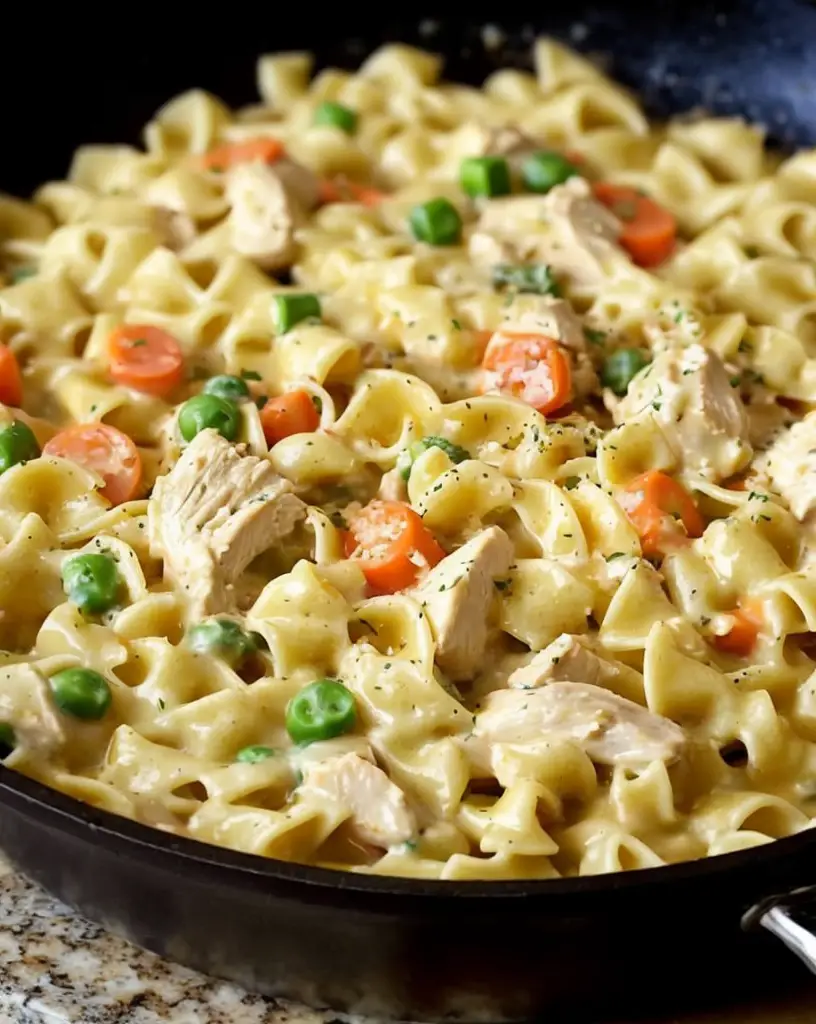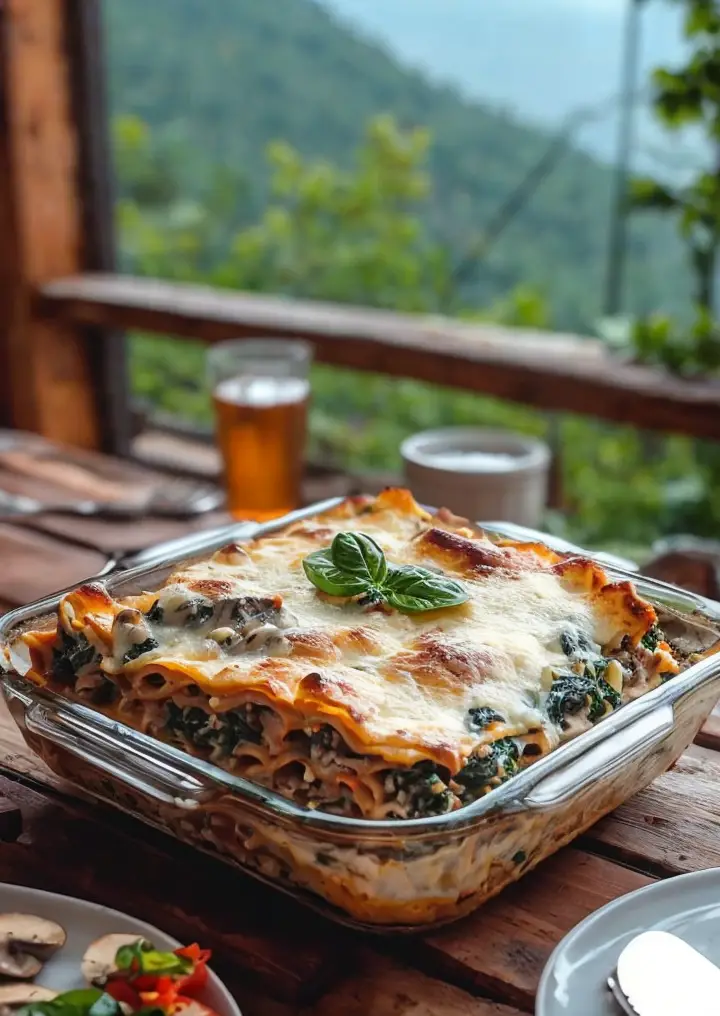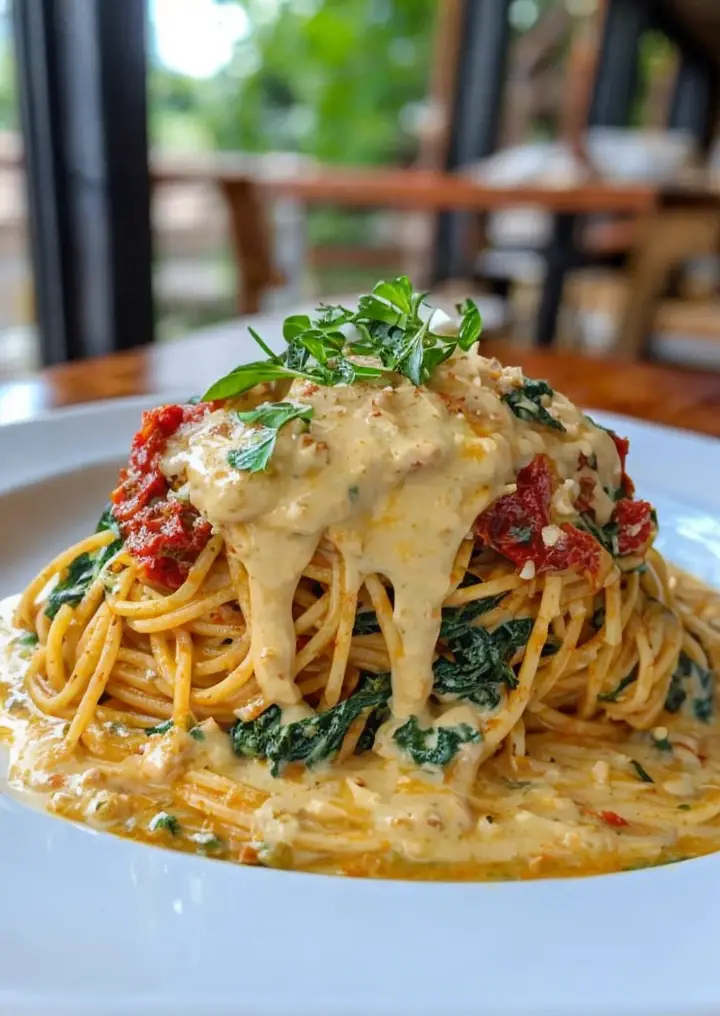Cajun Shrimp and Steak Alfredo Pasta: A Spicy Delight for Pasta Lovers
Indulge in the rich and creamy texture of Cajun Shrimp and Steak Alfredo Pasta, an exquisite dish that fuses the spicy zest of Cajun seasoning with savory steak and succulent shrimp. This recipe unleashes a wave of flavors, as the perfectly cooked shrimp and tender beef meld into a decadent Alfredo sauce. Each bite provides a delightful experience, balancing rich creaminess with a hint of spiciness that tantalizes the palate. Whether you are looking to impress guests at a dinner party or simply enjoy a comforting meal at home, this dish is sure to become a beloved favorite.
The combination of seafood and steak might sound unusual, but it works beautifully. The creamy Alfredo sauce clings to the noodles, infusing each bite with layers of flavor. The Cajun seasoning not only adds vibrant color but also a warmth that perfectly complements the richness of the sauce and proteins. Topped with fresh parsley and a sprinkle of Parmesan, this pasta dish is as appealing to the eyes as it is to the taste buds, making it a feast for all senses.
Quick Recipe Highlights
- Flavor Profile: This dish offers a perfect marriage of creamy, spicy, and savory sensations that excite your taste buds. The responsiveness of shrimp combined with the robust flavor of seasoned steak creates a symphony of tastes.
- Texture: The pasta delivers delightful chewiness contrasted by tender shrimp and juicy steak. The creamy sauce envelops everything, adding a luscious mouthfeel for an exquisite dining experience.
- Aroma: The blend of Cajun spices fills your kitchen with an enticing aroma, inviting everyone to gather around the dining table. The garlic and herbs add an extra layer of scent that enhances the overall appeal.
- Visual Appeal: Visually stunning with vibrant pink shrimp, golden-brown steak, and fresh greenery, this dish is not only delicious but also gorgeous when served, appealing to anyone looking for a satisfying meal.
- Skill Level Needed: While it requires some cooking techniques, if you follow each step closely, even novice chefs can successfully create this impressive meal.
- Special Equipment: Only basic kitchen tools are necessary, like a good-quality pan and pot, making this recipe accessible to all aspiring home cooks.
Recipe Overview
- Difficulty Level: While Cajun Shrimp and Steak Alfredo Pasta is classified as moderate, the steps are straightforward and manageable for most cooks. Understanding cooking times for the proteins ensures everything comes together seamlessly.
- Category: This delightful dish fits well within the pasta category, making it suitable for lunch or dinner. It’s also hearty enough to stand alone or be served alongside a fresh salad.
- Cuisine: Deeply rooted in the Cajun food tradition, this recipe brings the flavors of Southern Louisiana to your kitchen, highlighting a balance of rich and spicy elements.
- Cost: Prepared with common yet flavorful ingredients, the cost remains reasonable. Budget-conscious cooks will appreciate that this dish doesn’t compromise on taste despite its luxurious appeal.
- Season: Cajun flavors shine year-round, but it’s especially enjoyable during the cooler months when creamy comfort food is needed the most.
- Occasion: Perfect for festive gatherings, casual weekday dinners, or a romantic night in, this recipe adapts beautifully to any occasion where good food is shared.
Why You’ll Love This Recipe
Dive deep into the deliciousness of Cajun Shrimp and Steak Alfredo Pasta. Not only does it provide delightful taste and texture combinations, but it also brings convenience in preparation, allowing for a flavorful, hearty meal without extensive cooking time. With protein-rich shrimp and steak, it becomes a satisfying option for balanced nutrition, making it easy to maintain a wholesome diet while indulging in flavorful eating.
This dish offers incredible value for social gatherings. Impress friends with a sophisticated meal prepared at home, positioning you as a culinary standout among your peers. Its cost-effectiveness allows for batch preparation and sharing, making it perfect for family dinners, parties, or casual get-togethers. Financially, you won’t break the bank while still serving a gourmet-quality pasta dish.
Historical Background and Cultural Significance
Discovering the roots of Cajun cuisine traces back to the Acadian exiles of Canada, who settled in Louisiana. This unique blend of cultures incorporated local ingredients and cooking techniques, giving rise to a flavor profile that embodies both traditional and new influences. The use of seafood, such as shrimp, reflects the region’s bountiful waters, while the introduction of spices showcases a connection to West African and French culinary traditions.
Cajun food holds significant cultural importance, recognized for its use of spices and bold flavors. This dish represents the delightful evolution of Cajun cuisine, reflecting how it has adapted to modern tastes while staying true to its historical roots. Over time, Cajun recipes incorporated more diverse ingredients, appearing in various forms across different dining trends.
Regional variations can be found in Louisiana, where each community adapts recipes using locally available ingredients, creating unique interpretations of classic dishes. From the spice blends to protein choices, Cajun cuisine continues to evolve, demonstrating that it remains an integral part of American culinary culture.
Ingredient Deep Dive
For this Cajun Shrimp and Steak Alfredo Pasta, the key ingredients include pasta, shrimp, steak, heavy cream, and Cajun seasoning—each contributing not only to flavor but to the cultural significance behind the dish.
**Pasta** serves as the foundation of this recipe, prominently featured in various culinary traditions. While commonly made from wheat, whole-grain and gluten-free options are widely available. When selecting pasta, look for artisanal brands that provide robust flavors. Store it in a cool, dry place, and it can last for an extended period. Substitute with zucchini noodles or whole wheat for healthier versions.
**Shrimp** holds deep-rooted significance in coastal regions, often associated with Southern cooking. Nutritious and versatile, shrimp is a fantastic source of protein and essential vitamins. When selecting shrimp, opt for fresh or frozen wild-caught varieties. Store them properly on ice to maintain freshness, preferably using them within two days of purchase.
**Steak**, especially when used in pasta dishes, offers rich flavor and hearty protein. Look for high-quality cuts like sirloin or ribeye. Its nutritional benefits include iron and vitamin B12, contributing positively to your overall health. Store raw meat properly in the refrigerator and cook it to a safe internal temperature. For a lighter option, substituting chicken or tofu can appeal to varied dietary preferences.
Common Mistakes to Avoid
- Overcooking the pasta: This leads to a mushy texture that clashes with the creamy sauce. Always check for al dente doneness before draining.
- Using low-quality Alfredo sauce: While you might save money, homemade sauces provide superior flavor. Ensure you’re using fresh ingredients for the best results.
- Not seasoning the proteins: Properly seasoning both shrimp and steak enhances their natural flavors. Don’t be shy with the Cajun seasoning for that extra kick!
- Using too much oil: When sautéing proteins, too much oil can lead to greasiness. A balanced approach provides the needed richness without overpowering the dish.
- Failing to let the meat rest: Allowing steak to rest after cooking keeps it juicy and flavorful. Don’t skip this important step for optimal tenderness.
- Rushing the sauce: Alfredo sauce takes time to develop its flavors. Letting it simmer allows for a rich depth of taste.
- Skipping fresh herbs: Garnishing your dish with fresh parsley or cilantro not only brightens the flavors but enhances the dish’s overall appearance.
- Not tasting along the way: Always taste your food as you cook to adjust the seasonings and flavors to your preference.
Essential Techniques
Developing the right techniques contributes significantly to the success of Cajun Shrimp and Steak Alfredo Pasta. One important method involves mastering the art of al dente pasta cooking. Understanding when to drain and not overcooking pasta leads to dishes that retain better texture.
Searing proteins correctly is equally vital. Start with a hot pan and cook without moving the shrimp or steak too early to achieve that beautiful crust. Pay attention to visual cues, such as fading opaqueness in shrimp, to prevent overcooking.
Creating the perfect Alfredo sauce requires precision in simmering. It’s best to melt butter gently, adding cream gradually while stirring continuously for a smooth consistency. Employing the right heat ensures that the sauce stays creamy and doesn’t curdle.
Pro Tips for Perfect Cajun Shrimp and Steak Alfredo Pasta
To elevate your Cajun Shrimp and Steak Alfredo Pasta, take note of these pro tips. Start by seasoning your pasta water generously; it’s the first layer of flavor that infuses your dish.
When cooking shrimp, watch for the color change; as they cook, they go from gray to a bright pink shade, indicating doneness. Aim for that perfect shrimp that’s juicy on the inside yet have a little char on the surface.
Experiment with different levels of spice based on your preference. If you like it extra spicy, add a pinch of cayenne or some diced jalapeños for an added kick.
Let the cooked steak rest for at least five minutes before slicing it to ensure it retains all its juices, making each bite tender and flavorful.
Consider swapping heavy cream for a lighter option like half-and-half if you’re looking for a creamier sauce while lowering the calories.
Presentation matters, so take the time to plate beautifully. Twirl the pasta in the center of the plate, slice the steak neatly, and nestle the shrimp adorningly.
Finally, don’t forget the garnish. A touch of freshly chopped parsley not only adds color but a refreshing bright note against the richness of the dish.
Variations and Adaptations
Cajun Shrimp and Steak Alfredo Pasta invites creativity through various adaptations. Consider regional variations that incorporate local seafood or proteins, such as Gulf shrimp or Andouille sausage for a homage to traditional southern styles.
Seasonal adaptations can include adding fresh vegetables like asparagus or baby spinach, enhancing nutritional value and providing a pop of color. For health-conscious eaters, replacing half of the pasta with zucchini noodles offers a low-carb twist while keeping the essence of the dish intact.
Dietary modifications allow for inclusivity. For gluten-free adaptations, polynomial your pasta with alternatives made from chickpeas or brown rice. Vegan options can replace dairy-based ingredients with cashew cream and plant-based proteins, maintaining the heartiness of the original dish.
Flavor variations open further avenues; try experimenting with different spice blends like black pepper, smoked paprika, or even adding a splash of lemon juice for brightness.
Texturally, consider adding crunchy toppings like toasted breadcrumbs or crushed nuts to create an interesting contrast against the creamy sauce. Finally, tweak the presentation by serving in individual bowls or using unique servingware to elevate dining experiences.
Serving and Presentation Guide
To serve Cajun Shrimp and Steak Alfredo Pasta beautifully, focus on plating techniques that highlight its vibrant colors and varied textures. Start with a generous amount of pasta at the center of the plate and elegantly twirl it for height and visual appeal.
Garnishing is key; sprinkle freshly chopped herbs like parsley or chives for a touch of green. You can also drizzle a small quantity of high-quality olive oil or a hint of paprika oil around the edges to enhance the look and add a flavor boost.
Consider traditional accompaniments like garlic bread or a light arugula salad on the side, which provides a fresh contrast to the creamy pasta, brightening the flavors of the dish.
For modern serving suggestions, try individual portions in mason jars or bowls, creating a rustic yet chic dining experience. Temperature is crucial; serve your dish immediately after plating to enjoy its creamy, aromatic flavor at its peak.
Mindful portion control also matters. Serving appropriate portions ensures that guests can enjoy this rich meal without feeling overly indulgent.
Wine and Beverage Pairing
The right beverages elevate the experience of Cajun Shrimp and Steak Alfredo Pasta. Pairing a chilled Sauvignon Blanc or a zesty Chardonnay complements the rich flavors in the dish, offering a refreshing contrast.
For those preferring red wines, a light-bodied Pinot Noir can enhance the dish’s meatiness without overwhelming it. Consider a quality rosé for a delightful blend that suits the pasta while offering a refreshing lift against the creamy profile.
If you’re looking for non-alcoholic alternatives, iced tea or sparkling water infused with lemon provides a crisp choice that cleanses the palate.
Heating temperatures and serving styles for these beverages are important. White wines should be served chilled, while reds are ideal at cellar temperature—this balance ensures that flavor profiles remain intact and enjoyable.
Enhance the experience further by preparing a signature cocktail with flavors that echo the Cajun spices, delivering a themed celebration at your table.
Storage and Shelf Life
To store Cajun Shrimp and Steak Alfredo Pasta correctly, allow it to cool to room temperature before placing it in airtight containers to maintain its quality. Refrigerate leftovers and handle them within three to four days for optimal taste and safety.
Recognize signs of spoilage such as sour smells, discoloration, or an odd texture when reheating. It’s critical to take special care when reheating, as overcooked pasta continues to absorb liquid and may become mushy.
Reheat gently in a skillet with a splash of milk or cream to help restore creaminess without losing texture. Alternatively, utilize the microwave at low power, checking frequently to avoid overheating it.
If you wish to freeze, consider portioning the pasta in containers or freezer bags for later use. Consume frozen leftovers within a month or two for the best flavor and texture.
Make Ahead Strategies
Making Cajun Shrimp and Steak Alfredo Pasta in advance is possible with some strategic planning. Begin by prepping ingredients like chopping parsley, slicing steak, and thawing shrimp a day ahead to cut down on kitchen time.
You can prepare the sauce and store it in the refrigerator to enhance its flavors overnight. Just warm it gently on the stove before combining with freshly cooked pasta.
When storing between steps, allow shrimp and steak to be marinated while you prepare other elements, maximizing flavor absorption without added timing stress.
Quality assessments matter as some elements may not hold up when prepared ahead. Avoid cooking the shrimp and steak ahead of time, as they are best when freshly prepared. Assemble the pasta with its sauces just before serving.
Finally, consider adding any fresh elements, like herbs or vegetables, just before serving to ensure optimal freshness and vibrant flavors.
Scaling Instructions
For those looking to adjust recipes, halving or doubling the Cajun Shrimp and Steak Alfredo Pasta is straightforward. Adjust the quantities of pasta, shrimp, and steak accordingly to maintain balance in flavor and texture.
When doubling or tripling ingredients, be cautious with the sauce. Adjusting the amounts for seasonings may be necessary, as flavors can intensify during cooking times.
Equipment adjustments could include using larger pots for increased quantity, ensuring even cooking and well-integrated flavors. It’s prudent to monitor timing carefully, as larger quantities could require slightly more simmering time.
When scaling up, consider storage challenges for leftovers. Plan for sufficient container space for economical storage of portions to minimize waste.
Nutritional Deep Dive
Delve into the nutritional aspects of Cajun Shrimp and Steak Alfredo Pasta by analyzing its macro and micronutrient profiles. Protein-rich shrimp and steak deliver essential amino acids, vital for muscle health and overall wellness.
In terms of micronutrients, shrimp provides an excellent source of selenium, vitamin B12, and iron, contributing positively to your immune system and energy levels. Steak, meanwhile, is high in zinc and offers a good dose of protein, enhancing overall dietary balance.
Consider calorie intake, particularly with the heavy cream in the sauce. It’s essential to account for portion sizes, especially if you’re watching your caloric intake. Balancing this dish with lighter side options can help meet nutritional goals.
Weight management is feasible with this recipe, focusing on balanced portions while still enjoying the richness of flavors. Incorporate exercise and an active lifestyle to ensure overall wellness.
Dietary Adaptations
Those needing dietary modifications can enjoy Cajun Shrimp and Steak Alfredo Pasta through thoughtful adaptations. For gluten-free diners, selecting gluten-free pasta options ensures that this dish remains accessible.
Dairy-free alternatives can replace heavy cream with options like coconut cream or nut-based creams, achieving similar richness without dairy. With vegan modifications, swap shrimp and steak for plant-based proteins like tempeh or jackfruit, maintaining a filling and satisfying experience.
For low-carb or Keto adaptations, consider zucchini noodles instead of traditional pasta to lower carbohydrate content while keeping textures interesting. Employ fresh herbs to amplify flavors without relying on heavy sauces.
Paleo choices can incorporate sweet potatoes as a base, while still enjoying those spicy Cajun flavors without processed ingredients.
Other specific diets, like low-FODMAP, can benefit from ingredient substitutions to prioritize digestive health while enjoying bold flavors in moderation.
Troubleshooting Guide
Navigate common challenges when preparing Cajun Shrimp and Steak Alfredo Pasta. Texture issues often arise from overcooked shrimp. Aim for a quick cooking time and check the transition from gray to pink; this indicates doneness.
Flavor balance could waver if extra salt is added to the pasta water. Taste as you cook to prevent overwhelming flavors; adjust with a splash of lemon juice for brightness if needed.
Temperature problems may occur if shrimp cool too rapidly after cooking. Keep them warm in the skillet or on the stovetop, allowing them to incorporate flavor while you finish the sauce.
If using frozen shrimp, thawing properly is essential. Overcooked frozen shrimp can become rubbery; try quickly defrosting in cold water prior to cooking.
Adaptability options for hurried situations could require reheating catered to time constraints. Resetting flavors through herbs or a hint more cream can enhance tired dishes.
Recipe Success Stories
Share beloved community feedback for Cajun Shrimp and Steak Alfredo Pasta. Many have noted how they’ve received compliments from family and friends, showcasing the dish’s crowd-pleasing nature.
Cookstars often highlight their favorite adaptations. From suggesting fresh vegetable additions to creative plating ideas, readers find success in making this dish their own.
Readers also provide unique stories of experimenting with spice levels. Those daring enough to up the ante and embraced unexpected Cajun heat find exciting results in flavor profiles.
Photography tips, like emphasizing vibrant colors of shrimp and steak within creamy sauces, help capture the dish’s allure. Sharing these visuals on social media enhances community engagement as home cooks aspire to recreate similar scenes.
Explore variation suggestions within the comments, encouraging a lively exchange of ideas and creative enthusiasm, turning this dish into a collective culinary adventure.
Frequently Asked Questions
A1: Absolutely! Chicken is an excellent alternative. Choose a lean cut and cook it until golden brown for a delicious result.
Q2: How can I make this dish spicy?
A2: To increase the heat level, try adding cayenne pepper, red pepper flakes, or diced jalapeños to the sauce for an elevated kick.
Q3: Can I use low-fat cream options?
A3: Yes, using low-fat cream can create a lighter version of the Alfredo sauce, but the texture may be less rich.
Q4: Is this dish good for meal prep?
A4: Yes, it stores well in the fridge for 3-4 days and you can prepare your sauce ahead of time for convenience!
Q5: What variations can I try with the proteins?
A5: Feel free to mix it up! You could use sausage, scallops, or even plant-based proteins for diverse flavors. Each will bring something unique to the dish!
Q6: Can I make this recipe vegetarian?
A6: Indeed! Swap out the shrimp and steak for vegetables such as mushrooms, asparagus, and bell peppers, and use a veggie broth for enhanced flavor.
Q7: Should I rinse the pasta after cooking?
A7: No, it’s best not to rinse! Keeping the starch helps the sauce cling better to the pasta.
Q8: What’s the best way to reheat leftovers?
A8: Reheat in a skillet over medium heat, adding a splash of cream or milk to restore the sauce’s creaminess and prevent sticking.
Q9: Can I freeze this dish?
A9: While it can be frozen, creamy sauces may not hold up as well after thawing. Store it in an airtight container for up to a month.
Q10: What is the best kind of pasta for this recipe?
A10: Fettuccine or linguine are ideal for creamy saucy dishes, but feel free to use your favorite pasta shape!
Q11: How spicy is Cajun seasoning?
A11: The heat can vary depending on the brand. If you prefer less heat, start with a smaller amount and adjust to your taste.
Additional Resources
For those looking to explore further, countless resources are available to enhance your experience with Cajun Shrimp and Steak Alfredo Pasta. Explore related recipes featuring pasta dishes or other Cajun specialties that bring forth that rich, comforting flavor profile.
Consider reading technique guides that focus on mastering sauces, as they are foundational to many culinary delights. Ingredient information can also be beneficial for fresh sourcing, focusing on quality and seasonal availability.
Look for equipment recommendations that help streamline the cooking process, ensuring you have the right tools for the best results. Lastly, don’t forget to explore seasonal variations that can inspire new twists on this classic recipe, keeping the dish fresh and exciting.
Join the Conversation
Engagement is key in the world of culinary creations! Share your experiences with Cajun Shrimp and Steak Alfredo Pasta on social media, tag friends, and invite them to join your cooking adventures. Snap and post your culinary triumphs, showcasing artistic presentation and flavorful achievements.
Participate in recipe reviews to connect with others who love cooking. Your thoughts inspire fellow cooks and create a community where creative adaptations flow freely. Share your own variations or experiences with the recipe; your tips could guide someone else toward their culinary success!
The joy of creating and enjoying great food can further develop through community interaction, allowing you and fellow food enthusiasts to stay engaged and motivated in the kitchen.
The Recipe
Cajun Shrimp and Steak Alfredo Pasta
Serves: 4
Prep Time: 20 mins
Cook Time: 25 mins
Total Time: 45 mins
Kitchen Equipment Needed
- Large pot for pasta
- Skillet for sautéing
- Cooking spoon
- Measuring cups and spoons
- Knife and cutting board
Ingredients
- 8 oz fettuccine pasta
- 1 lb shrimp, peeled and deveined
- 1 lb flank steak, sliced thinly
- 1 cup heavy cream
- ½ cup grated Parmesan cheese
- 2 tbsp Cajun seasoning
- 2 tbsp olive oil
- Salt and pepper, to taste
- Fresh parsley, for garnish
Directions
- Cook the fettuccine according to package instructions until al dente. Drain and set aside.
- In a large skillet, heat olive oil over medium heat. Season the steak with Cajun seasoning, and cook until browned. Remove from the skillet and let rest.
- Add shrimp to the same skillet, season with remaining Cajun seasoning, and sauté until they turn pink and opaque. Remove and set aside.
- In the same skillet, pour in heavy cream and bring to a simmer. Stir in Parmesan cheese until melted and smooth. Season with salt and pepper as needed.
- Add cooked pasta to the skillet and toss to coat in the creamy sauce.
- Slice the rested steak and add it back to the skillet along with the shrimp. Gently mix to combine.
- Serve hot, garnished with fresh parsley and additional Parmesan cheese if desired.
Recipe Notes
- For a spicier kick, add more Cajun seasoning or a pinch of cayenne pepper.
- You can substitute heavy cream with half-and-half for a slightly lighter version.
- Incorporate seasonal vegetables like bell peppers or spinach for added nutrition.
